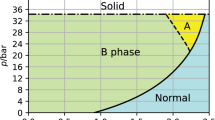Abstract
In this paper the quantum heat transport equation (QHT) is applied to the study of thermal properties of Planck gas, i.e., a gas of massive particles with mass equal to the Planck massM P = (łc/G)1/2 and whose relaxation time equals the Planck timeτ p = (łG/c 5)1/2. The quantum of thermal energy for a Planck gas,E Planck = 1019GeV, and the quantum thermal diffusion coefficientD Planck = (ħG/c)1/2 are calculated. Within the framework of QHT the thermal phenomena in a Planck gas can be divided into two classes: for a time period shorter thanτ p , the time reversal symmetry holds and for a time period longer thanτ p , time symmetry is broken, i.e., a time arrow is created.
Similar content being viewed by others
References
J. Marciak-Kozlowska, and M. Kozlowski,Found. Phys. Lett. 9 235 (1996).
D. Jou, J. Casas-Vasquez, and G. Lebon,Extended Irreversible Thermodynamics (Springer, Berlin, 1993).
R. Maartens,Class. Quantum Grav. 12, 1455 (1995).
P. G. Bergman, inCosmology and Particle Physics, V. de Sabbata and H. Tso-Hain, eds (Kluwer Academic, Dordrecht, 1994), p. 9.
Author information
Authors and Affiliations
Rights and permissions
About this article
Cite this article
Kozlowski, M., Marciak-Kozlowska, J. The time arrow in a Planck gas. Found Phys Lett 10, 295–299 (1997). https://doi.org/10.1007/BF02764210
Received:
Revised:
Issue Date:
DOI: https://doi.org/10.1007/BF02764210




